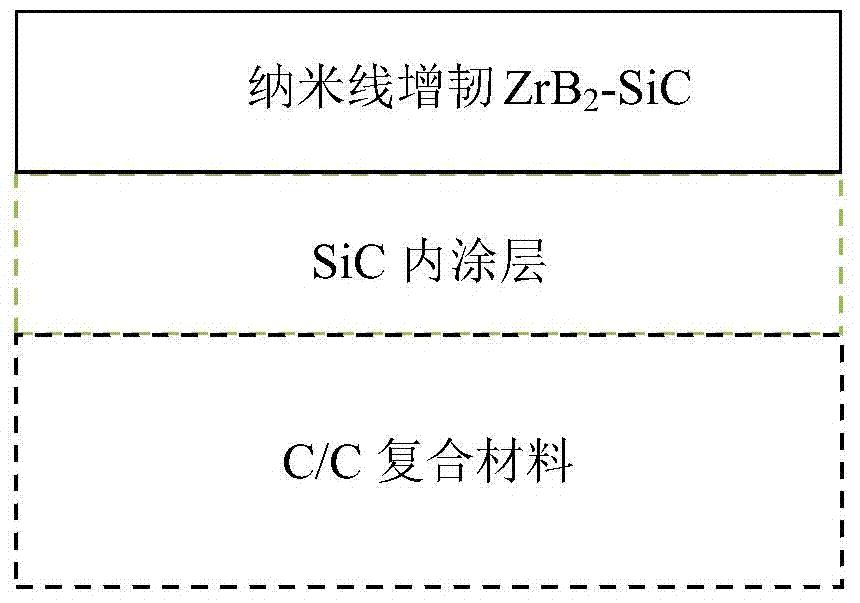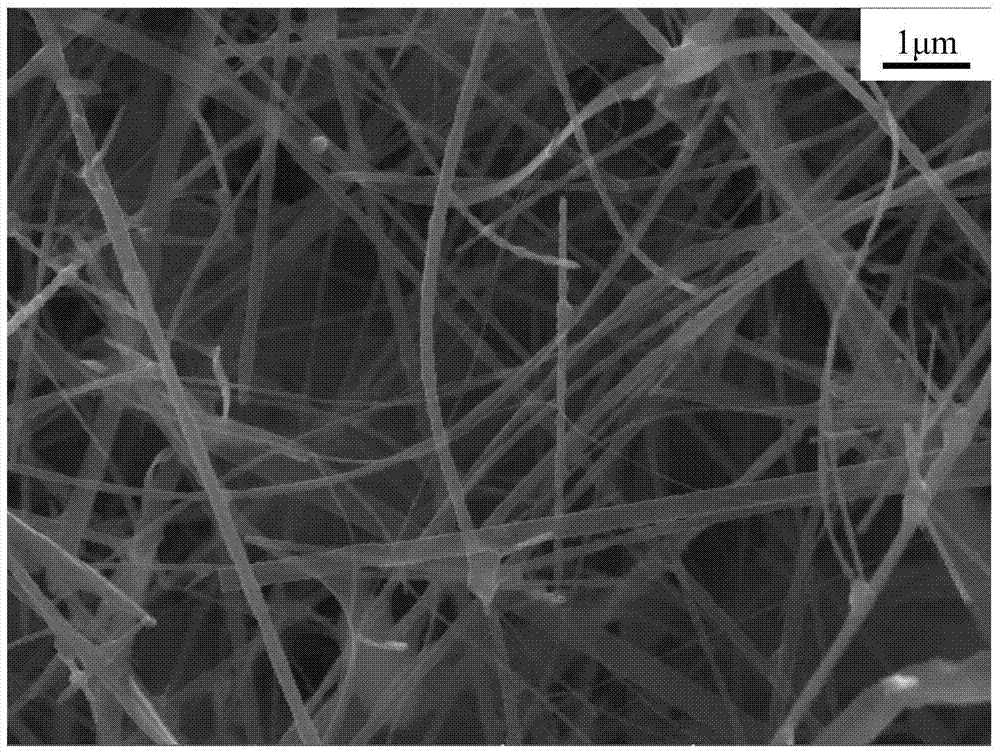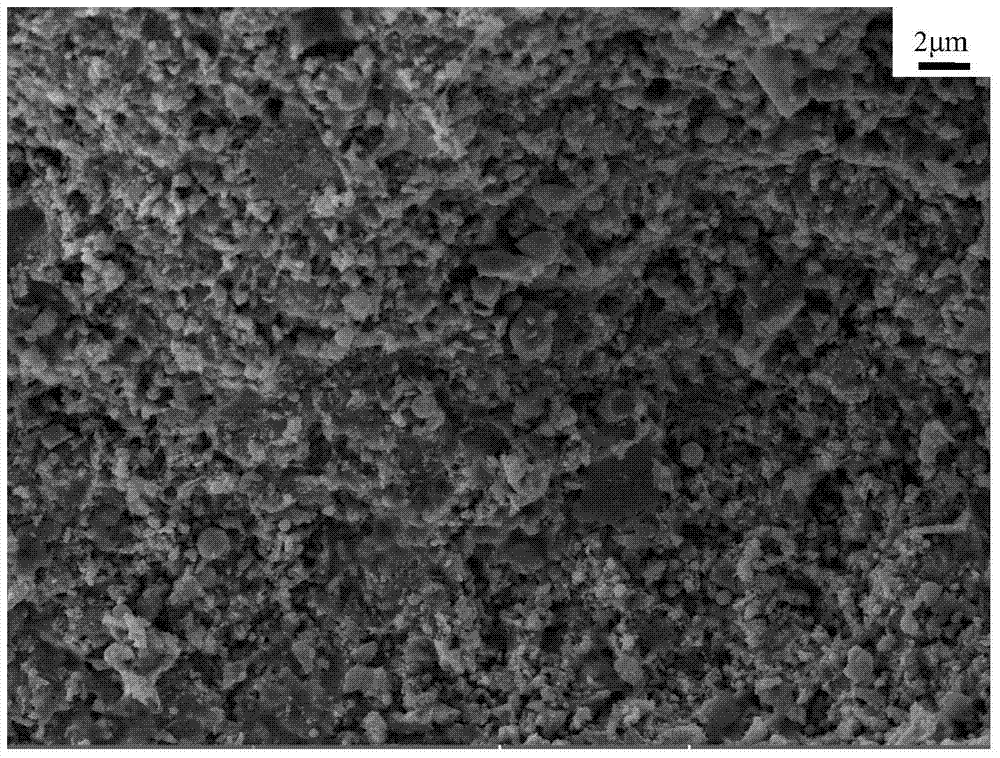SiC nanowire toughened high temperature ablation resistant ZrB2-SiC composite coating and preparation method thereof
A nanowire toughening and composite coating technology, which is applied in the field of coating on the surface of carbon/carbon composite materials, can solve the problems of poor coating performance, easy cracking and peeling of the coating
- Summary
- Abstract
- Description
- Claims
- Application Information
AI Technical Summary
Problems solved by technology
Method used
Image
Examples
Embodiment 1
[0055] The main process of preparing the high-temperature anti-ablation composite coating proposed in this example is: SiC inner coating prepared by embedding method, ZrB prepared by plasma spraying method 2 - SiC outer coating. The specific process is:
[0056] Step 1: Grind and polish the C / C composite material with No. 400, No. 800 and No. 1000 sandpaper in sequence, wash with absolute ethanol, and dry in an oven for later use. The drying temperature is 65-80°C.
[0057] Step 2: Prepare SiC inner coating. The specific process is:
[0058] 1) Weigh 77g of Si powder, 15g of C powder, and 8g of Al respectively 2 o 3 The powder was placed in a turpentine ball mill jar, and agate balls of different numbers and diameters were put into the ball mill jar and mixed for 3 hours to obtain a mixed powder, which was used as an embedding material for subsequent use.
[0059] 2) Put half of the prepared mixed powder into the graphite crucible, then put the cleaned and dried C / C comp...
Embodiment 2
[0069] The SiC nanowires proposed in this example toughen ZrB 2 - The main process of preparing SiC high temperature anti-ablation composite coating is: SiC inner coating prepared by embedding method, SiC nanowire prepared by chemical vapor deposition method, ZrB prepared by plasma spraying method 2 - SiC outer coating. The specific process is:
[0070] Step 1: Grind and polish the C / C composite material with No. 400, No. 800 and No. 1000 sandpaper in sequence, wash with absolute ethanol, and dry in an oven for later use. The drying temperature is 65-80°C.
[0071] Step 2: Prepare SiC inner coating. The specific process is:
[0072] 1) Weigh 77g of Si powder, 15g of C powder, and 8g of Al respectively 2 o 3 The powder was placed in a turpentine ball mill jar, and agate balls of different numbers and diameters were put into the ball mill jar and mixed for 3 hours to obtain a mixed powder, which was used as an embedding material for subsequent use.
[0073]2) Put half of ...
Embodiment 3
[0083] The SiC nanowires proposed in this example toughen ZrB 2 - The main process of preparing SiC high temperature anti-ablation composite coating is: SiC inner coating prepared by embedding method, SiC nanowire prepared by chemical vapor deposition method, ZrB prepared by plasma spraying method 2 - SiC outer coating. The specific process is:
[0084] Step 1: Grind and polish the C / C composite material with No. 400, No. 800 and No. 1000 sandpaper in sequence, wash with absolute ethanol, and dry in an oven for later use. The drying temperature is 65-80°C.
[0085] Step 2: Prepare SiC inner coating. The specific process is:
[0086] 1) Weigh 77g of Si powder, 15g of C powder, and 8g of Al respectively 2 o 3 The powder was placed in a turpentine ball mill jar, and agate balls of different numbers and diameters were put into the ball mill jar and mixed for 3 hours to obtain a mixed powder, which was used as an embedding material for subsequent use.
[0087] 2) Put half of...
PUM
| Property | Measurement | Unit |
|---|---|---|
| Mass ablation rate | aaaaa | aaaaa |
| Wire ablation rate | aaaaa | aaaaa |
| Mass ablation rate | aaaaa | aaaaa |
Abstract
Description
Claims
Application Information
 Login to View More
Login to View More - R&D
- Intellectual Property
- Life Sciences
- Materials
- Tech Scout
- Unparalleled Data Quality
- Higher Quality Content
- 60% Fewer Hallucinations
Browse by: Latest US Patents, China's latest patents, Technical Efficacy Thesaurus, Application Domain, Technology Topic, Popular Technical Reports.
© 2025 PatSnap. All rights reserved.Legal|Privacy policy|Modern Slavery Act Transparency Statement|Sitemap|About US| Contact US: help@patsnap.com



